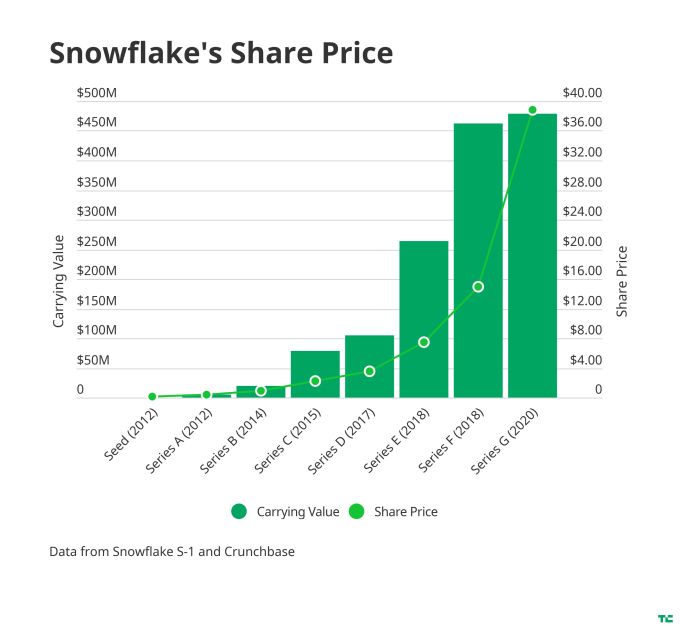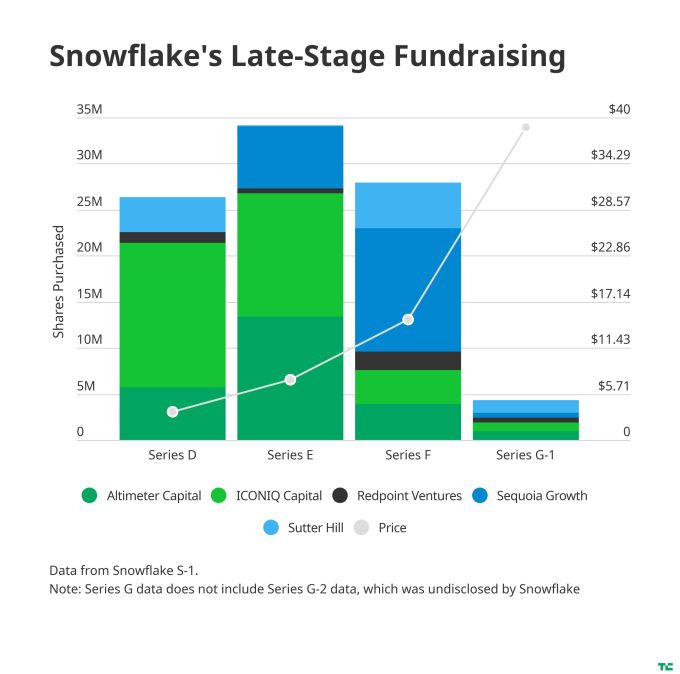When Snowflake filed its S-1 ahead of an upcoming IPO yesterday, it wasn’t exactly a shock. The company which raised $1.4 billion had been valued at $12.4 billion in its last private raise in February. CEO Frank Slootman, who had taken over from Bob Muglia in May last year, didn’t hide the fact that going public was the end game.
When we spoke to him in February at the time of his mega $479 million raise, he was candid about the fact he wanted to take his company to the next level, and predicted it could happen as soon as this summer. In spite of the pandemic and the economic fallout from it, the company decided now was the time to go — as did 4 other companies yesterday including J Frog, Sumo Logic, Unity and Asana.
If you haven’t been following this company as it went through its massive private fund raising process, investors see a company taking a way to store massive amounts of data and moving it to the cloud. This concept is known as a cloud data warehouse as it it stores immense amounts of data.
While the Big 3 cloud companies all offer something similar, Snowflake has the advantage of working on any cloud, and at a time where data portability is highly valued, enables customers to shift data between clouds.
We spoke to several industry experts to get their thoughts on what this filing means for Snowflake, which after taking a blizzard of cash, has to now take a great idea and shift it into the public markets.
Pandemic? What pandemic?
Big market opportunities usually require big investments to build companies that last, that typically go public, and that’s why investors were willing to pile up the dollars to help Snowflake grow. Blake Murray, a research analyst at Canalys says the pandemic is actually working in the startup’s favor as more companies are shifting workloads to the cloud.
“We know that demand for cloud services is higher than ever during this pandemic, which is an obvious positive for Snowflake. Snowflake also services multi-cloud environments, which we see in increasing adoption. Considering the speed it is growing at and the demand for its services, an IPO should help Snowflake continue its momentum,” Murray told TechCrunch.
Leyla Seka, a partner at Operator Collective, who spent many years at Salesforce agrees that the pandemic is forcing many companies to move to the cloud faster than they might have previously. “COVID is a strange motivator for enterprise SaaS. It is speeding up adoption in a way I have never seen before,” she said.
It’s clear to Seka that we’ve moved quickly past the early cloud adopters, and it’s in the mainstream now where a company like Snowflake is primed to take advantage. “Keep in mind, I was at Salesforce for years telling businesses their data was safe in the cloud. So we certainly have crossed the chasm, so to speak and are now in a rapid adoption phase,” she said.
So much coopetition
The fact is Snowflake is in an odd position when it comes to the big cloud infrastructure vendors. It both competes with them on a product level, and as a company that stores massive amounts of data, it is also an excellent customer for all of them. It’s kind of a strange position to be in says Canalys’ Murray.
“Snowflake both relies on the infrastructure of cloud giants — AWS, Microsoft and Google — and competes with them. It will be important to keep an eye on the competitive dynamic even although Snowflake is a large customer for the giants,” he explained.
Forrester analyst Noel Yuhanna agrees, but says the IPO should help Snowflake take on these companies as they expand their own cloud data warehouse offerings. He added that in spite of that competition, Snowflake is holding its own against the big companies. In fact, he says that it’s the number one cloud data warehouse clients inquire about, other than Amazon RedShift. As he points out, Snowflake has some key advantages over the cloud vendors’ solutions.
“Based on Forrester Wave research that compared over a dozen vendors, Snowflake has been positioned as a Leader. Enterprises like Snowflake’s ease of use, low cost, scalability and performance capabilities. Unlike many cloud data warehouses, Snowflake can run on multiple clouds such as Amazon, Google or Azure, giving enterprises choices to choose their preferred provider.”
Show them more money
In spite of the vast sums of money the company has raised in the private market, it had decided to go public to get one final chunk of capital. Patrick Moorhead, founder and principal analyst at Moor Insight & Strategy says that if the company is going to succeed in the broader market, it needs to expand beyond pure cloud data warehousing, in spite of the huge opportunity there.
“Snowflake needs the funding as it needs to expand its product footprint to encompass more than just data warehousing. It should be focused less on niches and more on the entire data lifecycle including data ingest, engineering, database and AI,” Moorhead said.
Forrester’s Yuhanna agrees that Snowflake needs to look at new markets and the IPO will give it the the money to do that. “The IPO will help Snowflake expand it’s innovation path, especially to support new and emerging business use cases, and possibly look at new market opportunities such as expanding to on-premises to deliver hybrid-cloud capabilities,” he said.
It would make sense for the company to expand beyond its core offerings as it heads into the public markets, but the cloud data warehouse market is quite lucrative on its own. It’s a space that has required a considerable amount of investment to build a company, but as it heads towards its IPO, Snowflake is should be well positioned to be a successful company for years to come.

![]()







